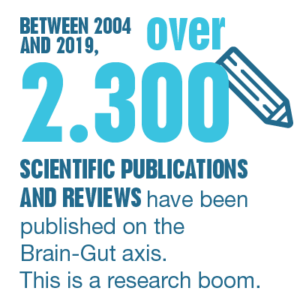Brain-Gut axis: a long-term relationship

The Brain-Gut axis is a health concept that started to spark some interest as early as the 1880s, when scientists and clinicians perceived a relationship between the brain and the gut, along with the gut’s resident bacteria.

Brain-Gut axis: a bidirectional communication
As research progressed, there was additional evidence of this bidirectional communication which intensifies in times of stress. The Brain-Gut axis is mainly composed of three pathways: the neural pathway (enteric nervous system and the vagus nerve), the neuroendocrine pathway, and the immune pathway. The gut is sometimes referred to as a “second brain”, as it hosts the enteric nervous system (ENS), a 300 million-nerve strong neural network allowing the gut to work without instructions from the brain [Liang, 2018]. The ENS controls the digestive system and plays an important role in peristalsis, secretion, and pain perception.
Brain-Gut axis and the microbiome relationship
The gut also provides food and shelter for the gut microbiome. As laboratory techniques and “omics” evolved with time, scientists have now a better understanding of these microorganisms. Current evidence indicates that the gut and its microbiome work together to affect immunity, endocrine functions, gut functions, and neurotransmission; the evidence continues to multiply. For example, recent research suggests that a high-fat diet may have a negative influence on both the gut microbiome and the brain. As well, a diet rich in saturated fatty acids can have detrimental effects, not only on the gut microbiome – characterized by lower diversity in gut microbial species – but also on brain function, inducing depression-like behavior [MyNewGut project].